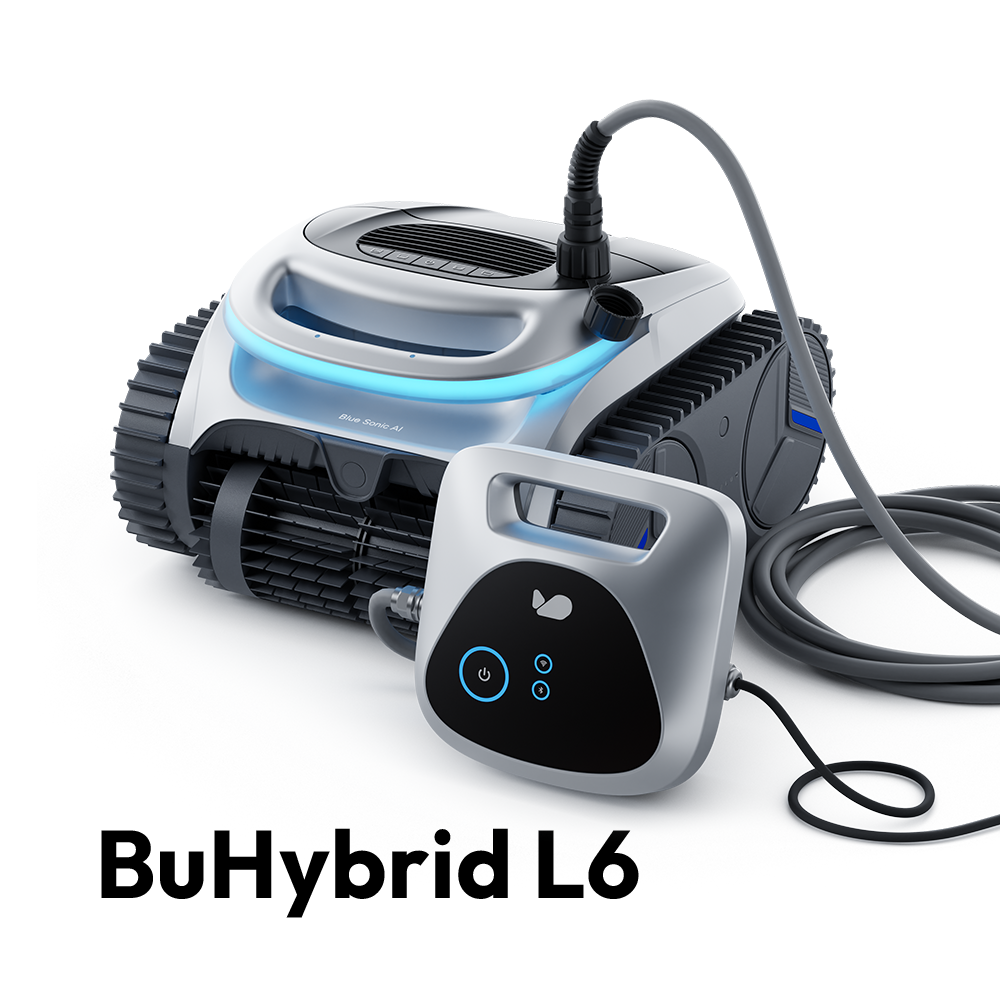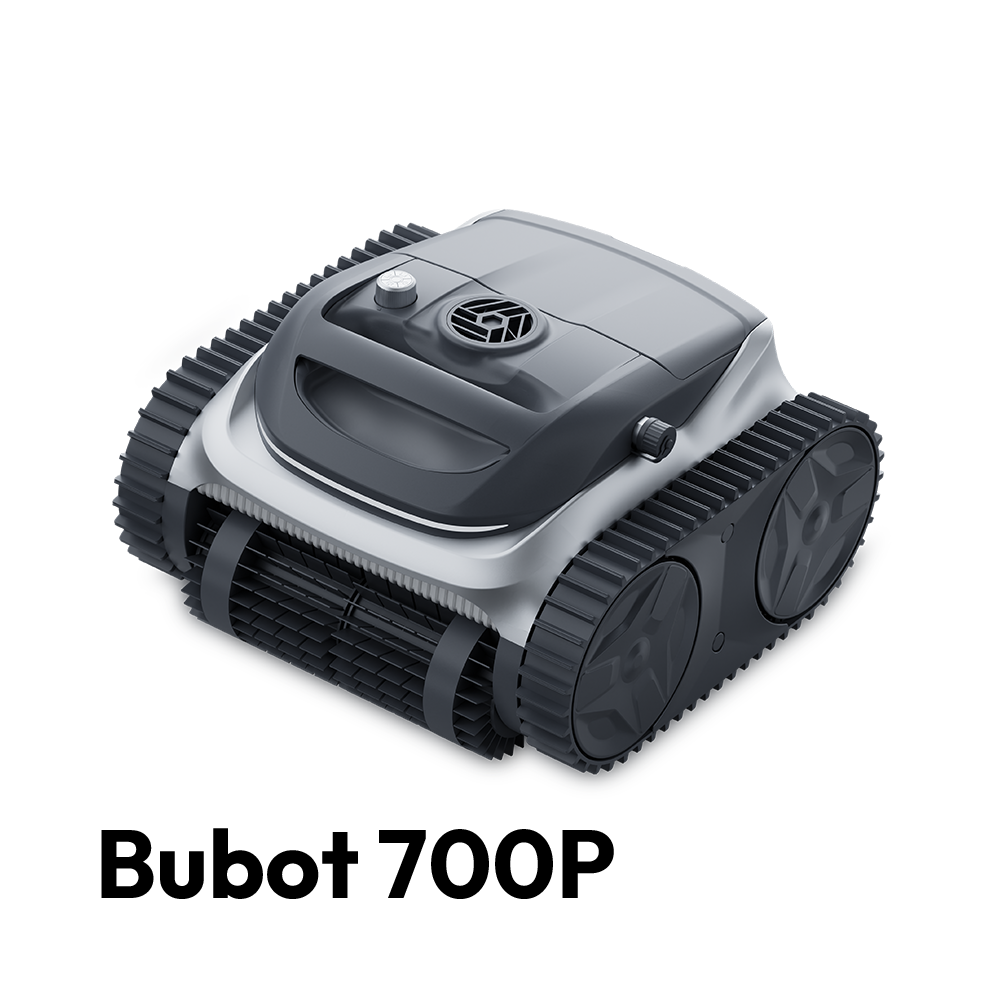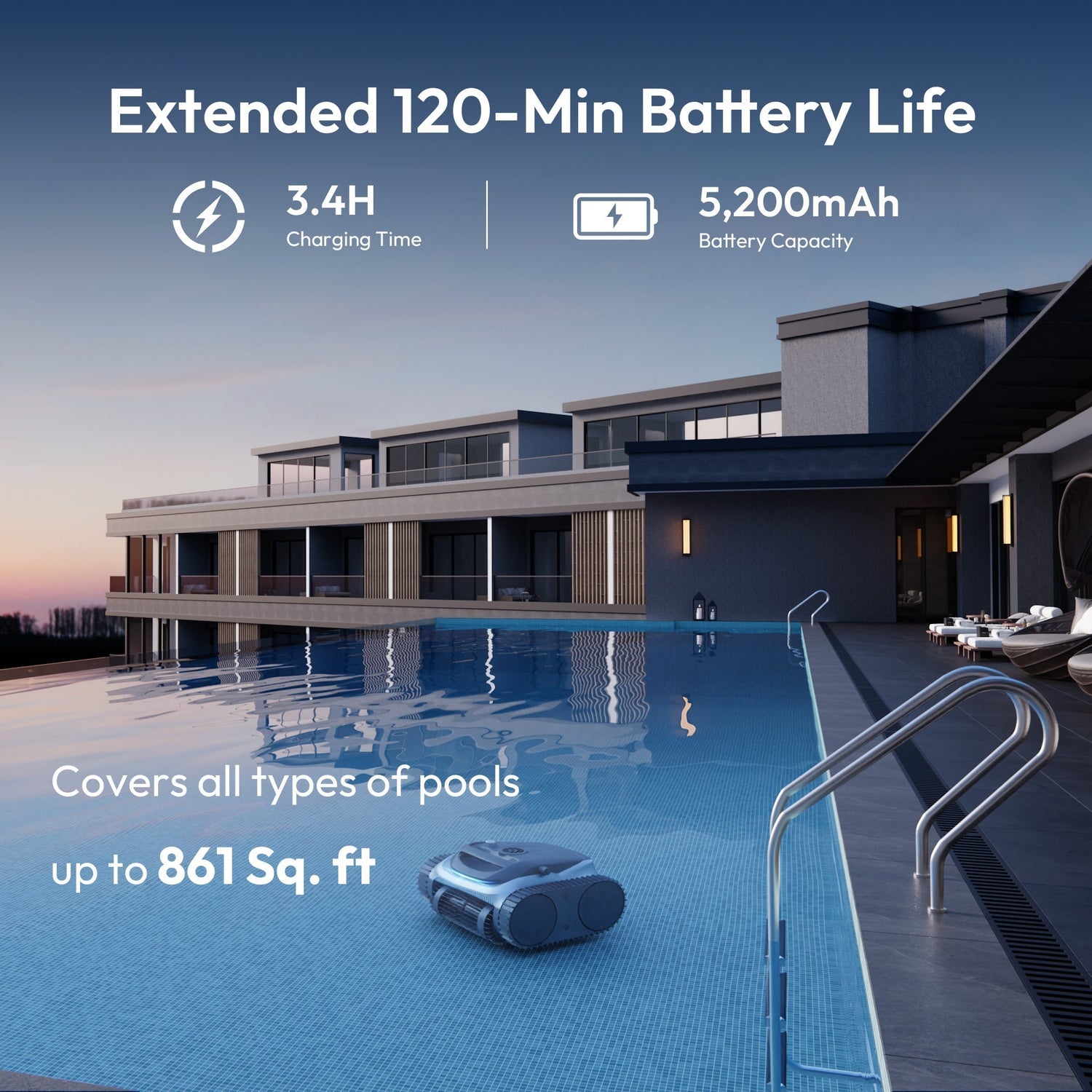
Have you ever watched your pool fill up with leaves and dirt, then wondered which pool cleaner will actually get the job done? The best pool cleaner robot for you really depends on your pool’s size, shape, surface, and cleaning needs. For example, a pool with a vinyl floor needs a different cleaner than a pool with tile or plaster. Odd shapes or deep ends can make cleaning tough unless your pool cleaner has smart navigation or special mobility features. If you have a big pool, you’ll want a cleaner with a long cord and a large debris basket. Above-ground and inground pools also need different types of pool cleaners to avoid damage. Choosing the right pool cleaner pays off now and later, especially when you pick trusted bublue products.
Key Takeaways
-
Know your pool’s size, shape, surface, and debris to pick the right cleaner that fits your needs.
-
Choose a pool cleaner with smart navigation, strong suction, and proper brushes for your pool type.
-
Avoid cheap models that may fail or damage your pool; invest in trusted brands with good warranties.
-
Keep your pool cleaner well maintained by cleaning filters and checking parts regularly to extend its life.
-
Read reviews, consult experts, and try cleaners before buying to ensure the best match for your pool.
Pool Assessment
Choosing the right pool cleaner starts with knowing your swimming pool inside and out. You want a pool cleaner that fits your pool’s unique needs, so let’s break down what you should look for.
Size and Depth
First, think about the size of the pool and how deep it is. A small pool might only need a basic pool cleaner, but a large or deep pool needs a model with a longer cord and more power. If your pool is extra deep, make sure the pool cleaner can handle the depth without losing suction or getting stuck. Always check the specs to match the size of the pool to the pool cleaner’s range.
Shape and Design
Not all pools are simple rectangles. Some have curves, steps, or even unique shapes. This can make cleaning tricky. Many industry studies show that pool cleaner robots struggle with odd shapes or complex designs. Some pool cleaners now use smart sensors or AI to map out your pool and adjust their cleaning path. If your pool has lots of corners or a freeform design, look for a pool cleaner with advanced navigation features.
Tip: If you have a pool with lots of steps or a sloped floor, pick a pool cleaner that can climb and adapt to changes in surface.
Surface Type
Pools come with different surfaces like vinyl, tile, or plaster. Some pool cleaners work better on certain surfaces. For example, a pool cleaner with soft brushes is best for vinyl, while a model with strong scrubbing power works well on tile. Always match the pool cleaner to your pool’s surface to avoid damage and get the best clean.
Debris Type
What ends up in your pool? Leaves, sand, bugs, or maybe even toys? Large debris can block or damage a pool cleaner. Before you run your pool cleaner, remove big objects from the pool. This helps the pool cleaner work better and last longer. Regularly cleaning out the filter and checking for stuck debris keeps your pool cleaner in top shape.
-
Pick a pool cleaner with the right filter for your usual debris.
A little pool assessment goes a long way. When you know your pool’s needs, you can pick a pool cleaner that keeps your pool sparkling with less hassle.
Key Features
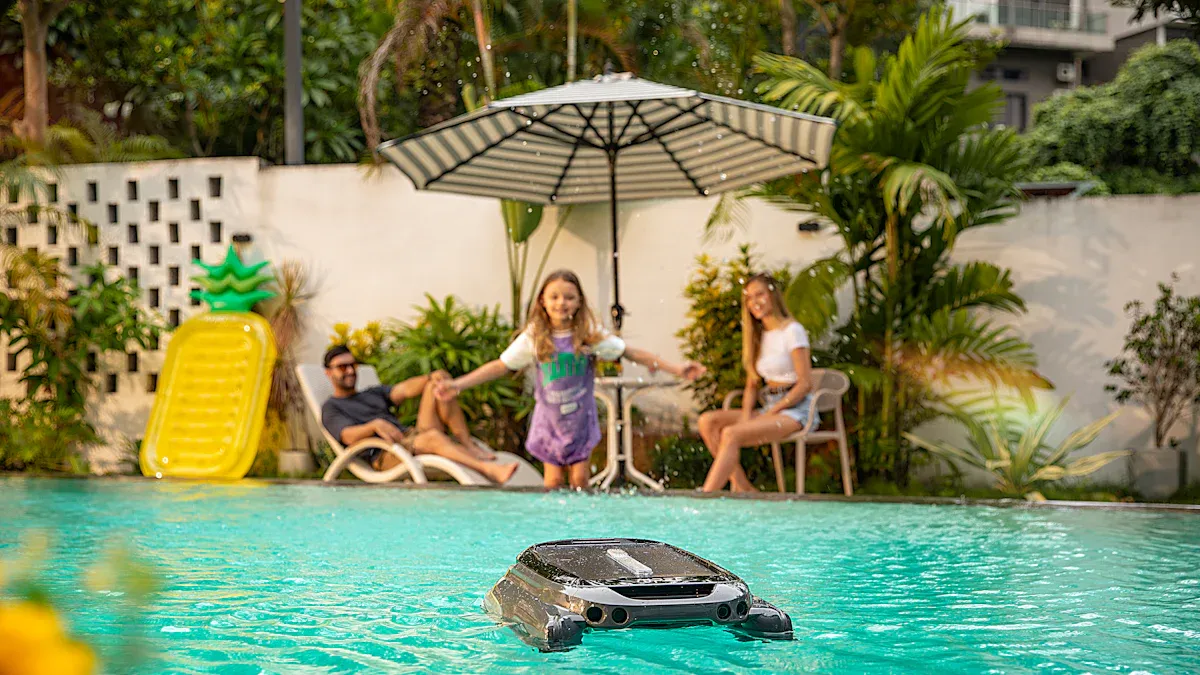
When you pick a pool cleaner, you want the best features for your pool. Let’s break down what matters most.
Navigation
A good automatic pool cleaner needs smart navigation. Some robotic models use gyroscopic sensors or AI to scan your pool and plan the best route. This means your pool cleaning robot can avoid obstacles and cover every inch. You get better cleaning and save time. Some electric robotic cleaners even change direction when they hit a wall, thanks to built-in microchips and sensors. This helps with tricky shapes and steps.
-
Dolphin Sigma and BWT Cosmy 200 use advanced navigation for precise cleaning.
-
Corded models often have better navigation than cordless ones.
Suction and Scrubbing
Suction power is key for any pool cleaner. You want strong suction power to pick up dirt, sand, and leaves. Many automatic pool cleaners use dual motors for extra suction power. Robotic models also have brushes that scrub the pool floor and walls. Some use special brushes, like polyvinyl alcohol, for better grip and cleaning. Electric robotic cleaners with strong suction power and scrubbing can handle tough debris and stains.
Tip: Look for a pool cleaner with adjustable suction power for different cleaning needs.
Filtration Options
Filtration keeps your pool water clear. A good pool cleaner has a strong filter that traps fine dirt and large debris. Some robotic cleaners offer different filtration options, so you can switch filters based on what’s in your pool. This helps improve cleaning performance and keeps your pool safe for swimming.
Cleaning Cycles
Automatic pool cleaners come with different cleaning programmes. You can set your pool cleaner to run for a quick clean or a deep clean. Some models let you schedule cleaning cycles for the week. This means your pool stays clean with less effort from you. Many users find that running multiple cleaning cycles removes fine dirt better.
-
Weekly timers and cleaning programmes make pool care easy.
-
Longer or repeated cycles boost cleaning results.
Connectivity
Modern pool cleaning robots offer smart connectivity. You can control your pool cleaner with your phone, set schedules, and get updates. Features like SmartNav and IoT make cleaning simple and efficient. Many people now choose automatic pool cleaners with these features for convenience and better results.
-
Smartphone control and real-time monitoring are popular.
-
Connectivity helps you manage cleaning without extra work.
With these key features, you can find a pool cleaner that fits your pool and makes cleaning easy.
Choosing a Pool Cleaner Robot
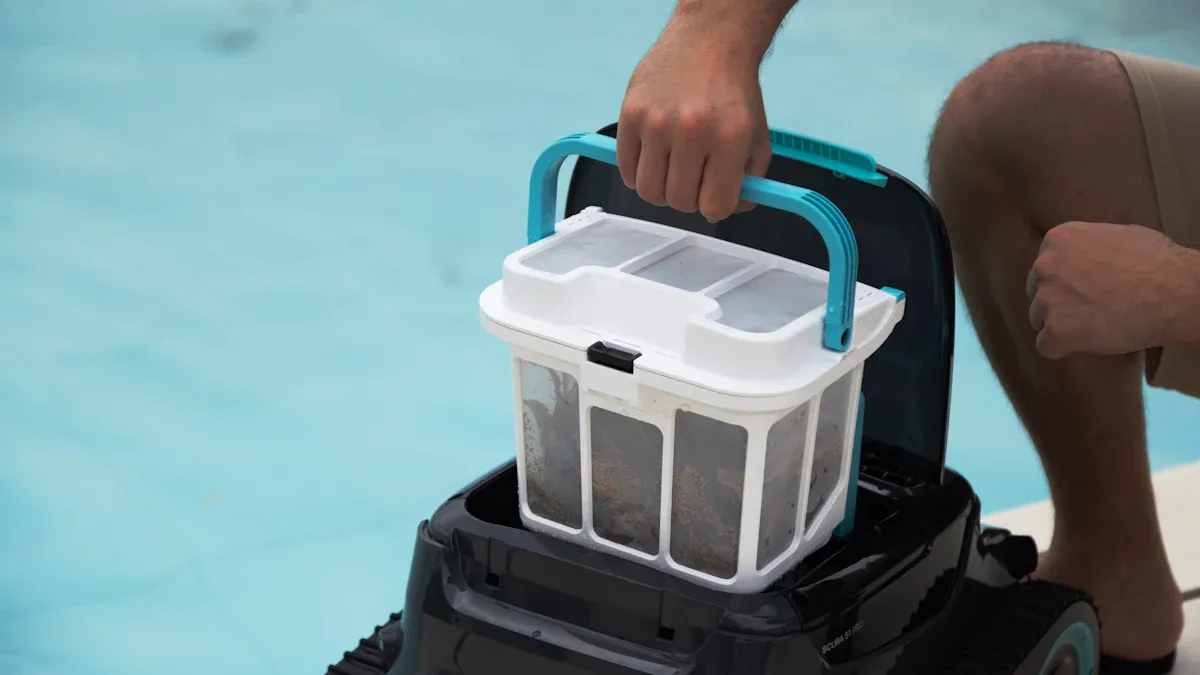
Matching to Pool Type
You want a pool cleaner robot that fits your pool like a glove. Not every pool cleaner works for every pool. Some pools have curves, steps, or deep ends. Others have smooth vinyl or rough tile. If you have an in-ground pool, you need a pool cleaner robot that can climb walls and reach the waterline. For above-ground pools, look for a model with safety bumpers to protect the liner. Hybrid pool cleaners work well if your pool has benches, steps, or corners that are hard to reach. These robots use different filters and smart navigation to clean every spot.
The Bublue 700P shows how a pool cleaning robot can handle tricky shapes. Its AI mapping system uses cameras and sensors to find every corner, step, and ledge. This means you get a cleaner pool, even if your pool has a unique design. Many users say this type of robotic pool cleaner picks up leaves and sand after storms and even helps lower chemical use.
Tip: Always check if the pool cleaner robot can handle your pool’s size and shape before you buy.
Energy Efficiency
You might wonder if a pool cleaner robot uses a lot of power. The good news is that most robotic models use about as much energy as a light bulb—only 100 to 200 watts per hour. They finish cleaning in two to three hours, so your monthly power bill only goes up by $8 to $15. That’s about 90% less energy than suction-side cleaners, which run your pool pump at high speeds every day.
Robotic pool cleaners also work on their own, so they don’t put extra strain on your pool’s filtration system. This means your pump and filter last longer, and you spend less on repairs. Hybrid pool cleaners save even more energy and need less maintenance because of their dual-filter designs. If you want to save money and help the environment, a robotic pool cleaner is a smart choice.
Budget and Value
You might see the price tag on a pool cleaner robot and feel a little sticker shock. Robotic models usually cost between $500 and $1,500. Suction cleaners cost less at first—sometimes under $200. But here’s the catch: robotic pool cleaners save you money over time. They use less energy, need fewer repairs, and help your pool equipment last longer. You can save around $442 a year just on energy and maintenance.
Let’s look at a quick comparison:
|
Aspect |
Robotic Pool Cleaners |
Suction Pool Cleaners |
|---|---|---|
|
Initial Cost |
Higher upfront cost |
Lower upfront cost |
|
Maintenance Parts |
Filter cartridges (1-2 years), tracks/brushes (2-3 seasons) |
Diaphragms, flappers, hose sections (more frequent) |
|
Maintenance Cost |
Higher for parts, but less frequent |
Lower for parts, but more often |
|
Lifespan |
4-5 years (premium: 10+ years) |
9+ years, but major repairs after 5-8 years |
|
Warranty |
Usually 3 years |
Usually 1 year |
|
Impact on Filtration System |
Reduces strain, extends life |
Increases strain, may clog |
|
Chemical Usage |
Reduces chemicals needed |
May increase chemical use |
|
Time and Labor Savings |
Saves time and effort |
Needs more manual work |
You also get more value from features like smart navigation, app control, and better cleaning cycles. Brands like bublue offer pool cleaner robots with advanced tech, strong suction, and easy maintenance. Compared to other brands, bublue stands out for its energy-saving features and user-friendly design. Some other brands may focus on lower prices, but they might not last as long or clean as well.
-
Pool ownership keeps growing, so more people want efficient cleaning.
-
New technology makes pool cleaning robots faster and easier to use.
-
You save time and money by letting the robot do the work.
-
Using less water and fewer chemicals is better for your wallet and the planet.
-
Even though the upfront costs are higher, you get long-term savings and a cleaner pool.
Note: Smart pool cleaning robots can pay for themselves in two to five years with energy and maintenance savings.
When you match the right pool cleaner robot to your pool, you get a sparkling pool, lower costs, and more free time. Take a close look at your pool, your budget, and your cleaning needs before you choose.
Mistakes to Avoid
When you shop for a pool cleaner, it’s easy to make mistakes that cost you time, money, and peace of mind. Let’s look at the most common pitfalls and how you can dodge them.
Buying Too Cheap
You might feel tempted to grab the lowest-priced pool cleaner you see online. Many people do this, but experts warn that cheap models often come with problems. These pool cleaners may not fit your pool, lack smart features, and wear out fast. Some low-cost pool cleaner robots even have fake reviews, making them look better than they are. Tools like Fakespot show that many ratings get inflated by review wiping or paid reviews. Safety can also be a concern. Some cordless models have had battery fires, which is a serious risk. Always choose a pool cleaner from a trusted brand with a real warranty.
Tip: Avoid black-colored pool cleaners. They can leave tough scuff marks on your pool surface. Go for blue, grey, or white instead.
Ignoring Maintenance
Every pool cleaner needs regular maintenance. If you skip this step, your pool cleaner will not last as long or work as well. You should clean the filters, check for stuck debris, and replace worn parts. Ignoring these tasks leads to higher costs and more frustration. Experts say that not thinking about long-term maintenance, replacement parts, and energy use can make your pool cleaner more expensive over time.
Overlooking Compatibility
Not every pool cleaner works with every pool. Some models only clean certain surfaces, like vinyl or tile. Others struggle with odd shapes or small pools. Consumer surveys show that many people buy a pool cleaner without checking if it matches their pool’s size, shape, or surface. This mistake means your pool cleaner might miss spots or not work at all. Always check the specs before you buy.
-
Some pool cleaners work best on vinyl or fiberglass.
-
Others are made for concrete or tile pools.
Skipping Warranty
A good warranty protects you if something goes wrong. If you skip this, you might pay for repairs or a new pool cleaner out of pocket. Experts recommend picking a pool cleaner with a solid warranty and proven performance. This gives you peace of mind and saves money in the long run.
Expert Tips
Read Reviews
You want to know what real people think before you buy a pool cleaner. Customer reviews give you honest feedback about how a pool cleaner works in different pools. Many users praise the Dolphin Premier for its strong cleaning power, easy maintenance, and helpful features like a weekly scheduler. People also like models with multiple filter options and full filter indicators. These features make pool care simple and boost user-friendliness. When you read reviews, look for comments about cleaning performance, reliability, and how easy it is to use the pool cleaner.
-
Check for reviews with lots of details about setup and daily use.
-
Pay attention to ratings and the number of reviews. More reviews often mean better trust.
-
Look for feedback on user-friendliness and how well the pool cleaner handles different debris.
Tip: Reviews often mention if a pool cleaner saves you time or if it needs lots of hands-on work.
Consult Professionals
Sometimes, you need expert advice to pick the right pool cleaner. Pool professionals test many models and know which ones work best for your pool type. They can explain the difference between corded and cordless models, safety features, and advanced filtration systems. Experts often recommend pool cleaners with strong filtration, smart navigation, and high user-friendliness. They also warn about safety issues, like battery problems in some cordless models.
A professional can help you match a pool cleaner to your pool’s size, shape, and surface. They also know which brands offer the best support and warranties. If you want peace of mind, ask a pool expert before you buy.
|
Pool Type |
Recommended Pool Cleaner |
Expert Insights |
|---|---|---|
|
Large inground |
Pentair Prowler 920 |
Strong suction, cleans walls |
|
Smart features |
Pentair Prowler 930W |
Wi-Fi, app control, energy-saving |
|
Aboveground |
Pentair Prowler 910 |
Lightweight, easy setup |
|
Cordless |
Cord-free, easy to move |
Try Before You Buy
Trying a pool cleaner before you buy can save you from disappointment. Some brands offer a 30-day trial, so you can test the pool cleaner in your own pool. This helps you see if it fits your cleaning needs and if it’s easy to use. Many people find that testing a pool cleaner shows its real strengths and any small issues. You get to check user-friendliness, cleaning power, and how well it handles your pool’s shape and debris.
-
Look for brands that offer risk-free trials.
-
Use the trial period to see how the pool cleaner works with your pool.
-
Pay attention to how easy it is to set up, clean, and store.
Note: A trial helps you make sure the pool cleaner matches your pool and your expectations before you spend your money.
You now have the tools to pick the best pool cleaner robot for your pool. Focus on your pool’s size, shape, and surface. Avoid buying too cheap or skipping maintenance. Think about long-term value, not just the price tag. Want more help? Check out reviews or talk to brands like bublue. Take the next step and enjoy a cleaner, easier pool life!
FAQ
How often should I run my pool cleaner robot?
You should run your pool cleaner robot two or three times a week. If you get lots of leaves or dirt, you might need to clean more often. Check your pool after storms or heavy use.
Can a pool cleaner robot clean steps and walls?
Most pool cleaner robots can climb walls and scrub steps. Some models do better than others. Look for robots with strong brushes and smart navigation if you want the best results on steps and walls.
Do I need to take my pool cleaner robot out after each use?
It’s a good idea to remove your robot after each cleaning cycle. This helps prevent wear and keeps the robot safe from sun and pool chemicals. Rinse it off and store it in a cool, dry place.
What kind of maintenance does a pool cleaner robot need?
-
Empty and rinse the filter after each use.
-
Check for stuck debris or worn parts.
-
Clean the brushes and wheels.
-
Store the robot out of direct sunlight.
Will a pool cleaner robot work in saltwater pools?
Yes, most pool cleaner robots work in saltwater pools. Just rinse the robot with fresh water after each use. This helps prevent salt buildup and keeps your robot running well.


